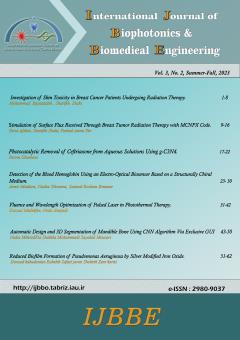Detection of the blood hemoglobin using an electro-optical biosensor based on a structurally chiral medium
محورهای موضوعی : Optical BiosensorsAmir Madani 1 , Nadia Ghorani 2 , Samad Roshan Entezar 3
1 - Department of Laser and Optical Engineering, University of Bonab, Bonab, Iran
2 - Department of Laser and Optical Engineering, University of Bonab, Bonab, Iran
3 - Faculty of Physics, University of Tabriz, Tabriz, Iran
کلید واژه: Photonic Band Gap, Structurally chiral medium, Blood hemoglobin, Circularly polarized light, Electro-optical Pockels effect,
چکیده مقاله :
In this work, a biosensor based on a structurally chiral medium (SCM) under the effect of a low-frequency electric field has been designed to detect blood hemoglobin. The introduced structure is irradiated with a circularly polarized light under an electro-optical Pockels effect. A photonic band gap is observed in the transmission spectrum of the right-handed circularly polarized waves, which indicates the circular Bragg phenomenon. The sensor consists of a sample layer sandwiched between two identical SCMs. Sensor performance is evaluated using the transfer matrix method (TMM). The results show that the defect mode is sensitive to any change in the refractive index of the defect layer where the defect layer is infiltrated with samples with different concentrations of blood hemoglobin. Also, it is shown that applying a low-frequency electric field increases the sensitivity of the mentioned sensor. It is observed that the sensitivity can be expanded up to 142.66 nm/RIU by changing the various parameters of the SCM.
[1] A. Lakhtakia and R. Messier, Sculptured Thin Films: Nanoengineered Morphology and Optics, 2005.
[2] J. C. Hernández and J. A. Reyes, “Optical band gap in a cholesteric elastomer doped by metallic nanospheres,” Physical Review E, vol. 96, pp. 062701 (1-6), 2017.
[3] J. Mendoza, J. A. Reyes, and C. G. Avendaño, “Optical band gap in a nanocomposite structurally chiral medium,” Physical Review A, vol. 94, pp. 053839 (1-5), 2016.
[4] C. G. Avendaño and L. O. Palomares, “Omnidirectional narrow optical filters for circularly polarized light in a nanocomposite structurally chiral medium,” Applied Optics, vol. 57, pp. 3119-3125, 2018.
[5] C. G. Avendaño and D. Martínez, “Tunable omni-directional mirror based on one-dimensional photonic structure using twisted nematic liquid crystal: the anchoring effects,” Applied Optics, vol. 53, pp. 4683-4690, 2014.
[6] J. A. Reyes and A. Lakhtakia, “Electrically controlled optical band gap in a structurally chiral material,” Optics Communications, vol. 259, pp. 164–173, 2006.
[7] H. Inan, M. Poyraz, F. Inci, M. A. Lifson, M. Baday, B. T. Cunningham, and U. Demirci, “Photonic crystals: emerging biosensors and their promise for point-of-care applications,” Chemical Society Reviews, vol. 46, pp. 366–388, 2017.
[8] H. Chen, R. Lou, Y. Chen, L. Chen, J. Lu, and Q. Dong, “Photonic crystal materials and their application in biomedicine,” Drug Delivery, vol. 24, pp. 775–780, 2017.
[9] S. K. Srivastava, C. J. M. van Rijn, and M. A. Jongsma, “Biosensor-based detection of tuberculosis,” RSC Advances, vol. 6, pp. 17759–17771, 2016.
[10] G. Pitruzzello and T. F. Krauss, “Photonic crystal resonances for sensing and imaging,” Journal of Optics, vol. 20, pp. 073004 (1-25), 2018.
[11] N. Ghorani, A. Madani, and S. R. Entezar, “Real-time biosensor application of structurally chiral medium for detection and sensing of plasma in human blood,” Physica Scripta, vol. 98, pp. 055518 (1-11), 2023
[12] H. J. El-Khozondar, P. Mahalakshmi, R. J. El-Khozondar, N. R. Ramanujam, I. S. Amiri, and P. Yupapin, “Design of one dimensional refractive index sensor using ternary photonic crystal waveguide for plasma blood samples applications,” Physica E: Low-dimensional Systems and Nanostructures, vol. 111, pp. 29–36, 2019.
[13] Z. A. Zaky and A. H. Aly, “Modeling of a biosensor using Tamm resonance excited by graphene,” Applied Optics, vol. 60pp. 1411-1419, 2021.
[14] S. E.-S. Abd El-Ghany, W. M. Noum, Z. S. Matar, Z. A. Zaky, and A. H. Aly, “Optimized bio-photonic sensor using 1D-photonic crystals as a blood hemoglobin sensor,” Physica Scripta, vol. 96, pp. 035501 (1-9), 2020.


